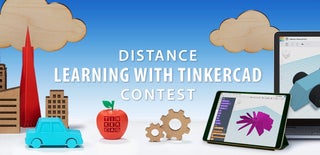Introduction: 3D Toys With Circuits
Usually my 6th graders make stuffed toys with circuits using sewable Lily components, but I didn't get to meet them in person. I decided to maintain the learning about circuits as much as possible and ask them to design toys in Tinkercad instead. Students have iPads so they used the app. In addition to the tutorials provided by Tinkercad, I made videos to help students learn to use Tinkercad and design circuits.
I'm submitting this to the Distance Learning with Tinkercad contest and it fits several categories because students had a lot of freedom to design what they wanted. You'll see toys that move, connect and mash up different components. All of them are silly solutions to the problem of not enough electronic toys in the world.
Supplies
To print and wire your toys, you will need the following:
3D Printer
3D Filament in a variety of colors
AAA Batteries
LEDs
*These were out of stock when I ordered, but these are links to the components that fit the pre-made Tinkercad parts.
Step 1: Learn About Circuits
Students watched a BrainPop video as an introduction to circuits then they used the Phet Circuit Simulation to practice constructing circuits. I introduced the simulator in a video I made. Next was a series vs parallel circuit video. After students spent some time learning Tinkercad and thinking about what they wanted to design, we returned to the subject of circuits. The Tinkercad circuit simulator doesn't work on the iPad so I made a video demonstrating with the components we were planning to use. Finally, there was a video about how to draw the circuit for the toy they wanted to create.
Step 2: Learn Tinkercad
After a short introduction to Tinkercad on the iPad, students completed several of the lessons including Spin, Move and Glow using the circuit components. In order to get students thinking about what they could make (and provide more instruction) I made Glow, Spin, and Move tutorials.
Step 3: Brainstorming Ideas
Students spend time thinking about a variety of things they could design for a toy. We used whiteboardfox.com to collaborate asynchronously. I made a tutorial about brainstorming and using the whiteboard.
Step 4: Wire & Assemble Toys
I printed students final designs and gathered all the electronic components each of them would need and mailed them. I made videos to help students wire their toys. Some students had a lot of different components to assemble and some were simpler. The dog and lacrosse helmet toys are mashups of gallery components. They also demonstrate movement. The airplanes and sailboats required thinking about how to connect the pieces. Overall, students learned a lot about constructing simple circuits and designing fun toys!
Wiring coin cell battery to LEDs, vibration motor & switch
Wiring AAA battery pack, motors & LEDs
Feel free to contact me in the comments for more information about the structure of the class and how students submitted their progress. Video Folder with all my videos in the order I used them in class.

Runner Up in the
Distance Learning with Tinkercad Contest












